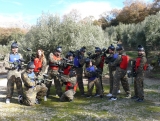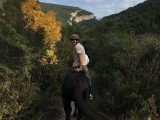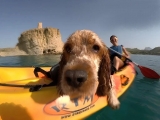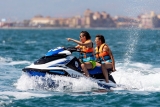
Do You Know the Best Dive Sites?
This park begins in the town of Retamar, about 15 kilometres from Almería, with the first dive site located near Torre García, roughly 300 metres from the shore. Known as "La Islilla de Torre García", its seabed ranges between three and eight metres deep.Just a few metres away, from the same lighthouse, you’ll see one of the park’s most iconic landscapes: "Los Arrecifes de las Sirenas". To dive here, you can start from a small jetty just a few metres long. Sheltered by the reefs, the dive is straightforward—though currents can be tricky, so we recommend diving before midday. Depth here reaches around 12 metres.
The Wreck of the "Arna"
Wreck diving is an incredible experience. Staying in the same area, your next reference point is "La Laja". You’ll follow the same route taken 65 years ago by the steamship "Arna", which sank after hitting "La Laja" en route to Almería. Today, thanks to this shipwreck, you can enjoy what is undoubtedly the park’s best dive: "El vapor del Cabo de Gata".This wreck rests perfectly on a sandy seabed, with its deepest point at 42 metres and the shallowest at 25 metres near the stern. The propeller is a must-see! The crystal-clear waters sometimes allow you to spot the wreck from the surface.

One curious fact: the Navy reportedly cut off the bridge for being a navigation hazard, and later, a company removed its engines, leaving the hull practically hollow. Exploring its holds is safe—it carried iron ore. But beware of strong currents in this area.
"Los Amarillos"
The next dive site, near San José, is "Los Amarillos". Named after its location opposite "Cala Amarilla" (a volcanic yellow cove), it features a sandy bottom at 15–23 metres.Nearby is "Cala Higuera", accessible via a rough dirt track (then a short swim). Though challenging to reach, the cliffside surface route is worth it.
From here, head to "Los Escullos" via the "Isleta del Moro" road. At "La Punta", you’ll swim past large rocks and posidonia meadows (stay under 15 metres). "El Embarcadero" is ideal for beginners due to its shallow depth.
The "Escullos" Area
Between Escullos and Cala Higuera, countless boat-accessible dive sites await: "El Chalet", "La Cueva del Francés", "Punta Escullos", and more. Land access is impossible.
Next, visit the fishing village "La Isleta del Moro". Dive its tranquil eastern side (10–12 metres) or the offshore "Piedra los Meros" (28–40 metres), once teeming with groupers.
Route: Las Negras
Heading east toward Las Negras, stop at "El Mirador de la Amatista" for stunning views. Pass Rodalquilar (a former gold-mining town) to reach "El Playazo", where a dirt road leads to a beachfront castle.Near Las Negras, explore "La Cueva de las Palomas" (shallow but stunning) and "Los Socabones" (12–16 metres), a rocky posidonia meadow. Further on, "Cerro Negro" offers excellent diving down to "Cala Hernández" (10–15 metres).

En route to Carboneras, dive at "El Plomo" and "Cala del Medio" before reaching Aguamarga. Between Aguamarga and Mesa Roldán lies "Punta de los Muertos", with caves, cracks, and abundant marine life (max 20 metres).
Finally, near Carboneras, explore "Isla de San Andrés" (5–30 metres) and its offshore sites—best visited with local dive centres.
In short, dozens of spectacular dive sites for all levels await your discovery.











